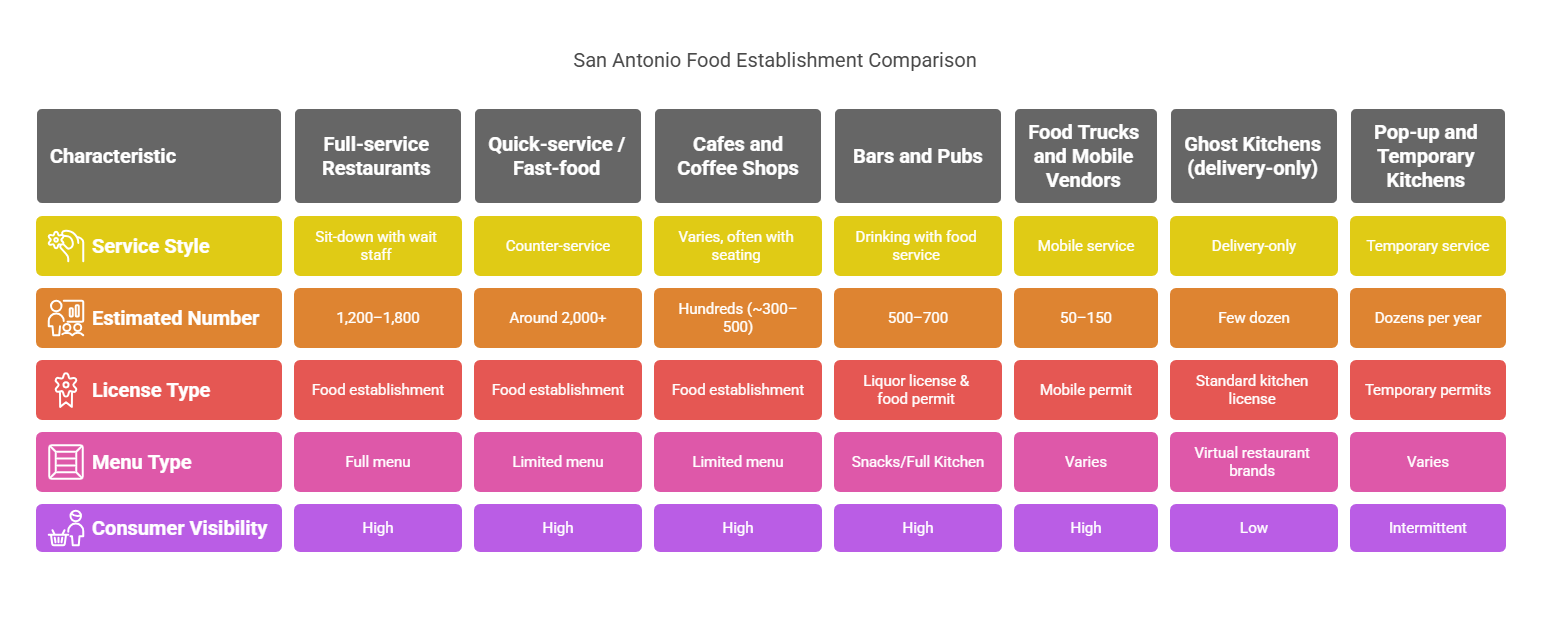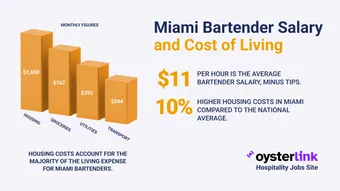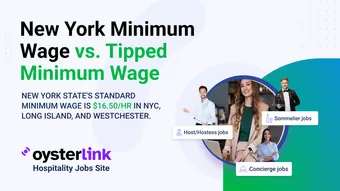Estimating the total number of restaurants in San Antonio in 2025 is challenging because no single public source lists every eatery. However, multiple data points suggest several thousand.
For example, the U.S. Bureau of Labor Statistics reports roughly 144,500 jobs in Leisure & Hospitality in the San Antonio area (Jan 2025). If one assumes an average of roughly 20–30 employees per restaurant (counting kitchen and wait staff), this implies on the order of 4,000–7,000 establishments.
A plausible mid‐point is on the order of ~5,000 restaurants citywide. This aligns with industry snapshots (e.g. a TripAdvisor directory excerpt in April 2025 cited “5,137 San Antonio restaurants” with over 169,000 reviews) and with the fact that San Antonio’s restaurant scene is large but somewhat smaller than Houston’s or comparable to Dallas’s, reflecting population rank.
Official Counts (Licenses and Records)
San Antonio’s Metro Health Department requires every restaurant or food service venue to hold a Food Establishment License. The city defines a “food establishment” broadly as “an operation that stores, prepares, packages, serves, or otherwise provides food for human consumption such as: a restaurant; retail food store; satellite or catered feeding location; [etc.]”.
In principle, then, every legally operating restaurant, café or food truck in the city appears in the health department’s license records. Unfortunately, the city does not publish an easy “count” of active licenses. (For example, SAMHD publishes fee schedules and rules but not a live directory of licensees.)
One can infer scale: the multiple tiers of license fees (ranging from ~$412/year for very small operations up to ~$1,240 for large ones) suggest dozens of fee bands, and the staff and costs involved imply thousands of active licenses.
At the state level, Texas does not centrally count city restaurants – local health districts handle that. Industry research (e.g. by the National Restaurant Association) indicates Texas has on the order of tens of thousands of restaurants statewide, so San Antonio’s share (by population) is significant.
In short, while we lack a single “official total,” the licensing framework and labor data both point to roughly 4–6 thousand food-service outlets in San Antonio.
Online Platforms vs. Official Records
Online review and mapping services often list even larger numbers. For example, TripAdvisor’s San Antonio dining page (April 2025) lists on the order of 5,000+ restaurants (with well over 100,000 reviews), and Yelp/Google Maps each show thousands of “restaurant” pins in the city. These online counts typically exceed official license totals for several reasons:
- Duplicate or outdated entries. Chains have multiple locations listed separately, and closed or relocated businesses sometimes remain listed.
- Listing of unlicensed or informal vendors. Food trucks, pop-ups, and delivery‐only “ghost kitchens” may appear online even if they lack a traditional storefront or up‐to‐date license record.
- Categorization differences. A café or market that serves food might be tagged as a “restaurant” on Google/Yelp even if it’s licensed as a retail food store.
Thus, an online search might return 5–6k results for “San Antonio restaurants,” while the city’s licensed count is somewhat lower. In practice, many industry analyses rely on a mix of sources: official employment/licensing data for a baseline, supplemented by aggregated listings to capture newer or unconventional operations.
Breakdown by Category
San Antonio’s eateries span all major food-service categories. Rough estimates (for 2025) include:

- Full-service restaurants – Sit-down establishments with wait staff (casual dining, upscale dining, family restaurants). These likely number on the order of 1,200–1,800. (These employ more staff per location, and thus form a sizeable share of leisure & hospitality jobs.)
- Quick-service / Fast-food – Counter-service restaurants, diners, chains, drive-thrus, etc. These are very common and may number around 2,000 or more. Chain fast-food outlets are particularly numerous (McDonald’s, Chick-fil-A, etc.), and local sub and taco shops also fall here.
- Cafes and coffee shops – Standalone cafés, coffeehouses, bakeries with seating. San Antonio has a growing coffee culture (e.g. local chains, artisanal bakeries). These establishments may number in the hundreds (est. ~300–500). Many are licensed as “food establishments” even if their menu is limited.
- Bars and pubs – Drinking establishments that serve food (often under a separate liquor license but still requiring a food permit). There are roughly 500–700 bars/pubs in San Antonio. (Some bars serve only snacks or prepackaged items, others have full kitchens.) This category overlaps with “restaurants” to some extent.
- Food trucks and mobile vendors – The city issues permits for dozens of food trucks and carts. While exact numbers vary (some come and go), at any time SA has on the order of 50–150 licensed food trucks/trailers roaming the city. (These are counted in health inspections but often under a mobile permit category.)
- Ghost kitchens (delivery-only) – These are commercial kitchens used solely to fulfill online orders for virtual restaurant brands. This segment is growing but still small (perhaps a few dozen operations in SA as of 2024). Ghost kitchens may operate under a standard kitchen license but are not easily visible to consumers.
- Pop-up and temporary kitchens – San Antonio hosts occasional pop-up restaurants and event food stalls. These operate under temporary permits and are hard to count; they contribute dozens of additional venues per year, but most are intermittent.
No public dataset breaks down the exact counts by category. The above figures are estimates informed by industry shares and local directories. (For context, nationally about half of all food-service outlets are limited-service (fast-food/cafés) and half full-service, so San Antonio’s mix is likely similar.)
The city’s health department licenses cover all these types, so any licensed venue falls into one of these groups. In summary, traditional restaurants (full- + limited-service) dominate the count, with a smaller but significant minority of cafes, bars, trucks, etc.
Distribution Across Neighborhoods
Restaurants in San Antonio cluster in certain districts:
- Downtown/River Walk: The central business district (CBD) and River Walk corridor is dense with eateries – from tourist-oriented Tex-Mex and steak houses to upscale hotels’ restaurants.
- Pearl District / Museum Reach: The redeveloped Pearl Brewery area and nearby Quarry District (north of downtown) have dozens of popular restaurants and breweries.
- Southtown/Kendall: The Southtown area, including South Alamo Street, South Flores, and the Blue Star Arts District, is rich in cafes, bars and restaurants.
- Alamo Heights / North Central: Along Broadway and in the Alamo Heights shopping districts (between downtown and Uptown San Antonio) are many family restaurants, chains, and unique cafes.
- Stone Oak / Northeast: Farther north (near Stone Oak and along the IH-35 corridor toward Castle Hills), suburban shopping centers host fast-food and casual chains.
- Far West / Northwest: On the west side near UTSA, many taco stands and fast-food spots line Bandera Road and Loop 1604.
Anecdotally, the highest “restaurant density” is downtown and central neighborhoods; outlying suburban areas have sparser coverage per square mile. Unfortunately no official map shows counts by zip code, but local guides and city planners recognize Downtown, Pearl, and major arteries (North St. Mary’s, Broadway, Blanco Rd., etc.) as dining hubs.
Comparison with Other Texas Cities
San Antonio is Texas’s second-most populous city (after Houston and Dallas; ahead of Austin). Its restaurant count scales roughly with population and tourism.
- Houston (metro ~2.3M) has a larger restaurant base (often cited as “over 7,000” eateries metro-wide) thanks to its size and diversity.
- Dallas–Fort Worth (metro ~7.5M, cities ~1.3M each) has a comparably large culinary scene; the City of Dallas alone likely hosts 5–6,000 restaurants.
- Austin (city ~1M) has fewer total restaurants than San Antonio, reflecting its smaller population (though per-capita dining is high in Austin due to tourism).
In per-capita terms, San Antonio’s ~5,000 restaurants (for ~1.5M people) is roughly on par with its peer cities. All three major Texas metros report tens of thousands of food-service jobs, with San Antonio’s 144,500 leisure/hospitality jobs fitting between Dallas’s and Houston’s totals.
In short, San Antonio’s restaurant count is large by Texas standards, though Houston’s and Dallas’s are still higher due to their larger metro populations.







Loading comments...